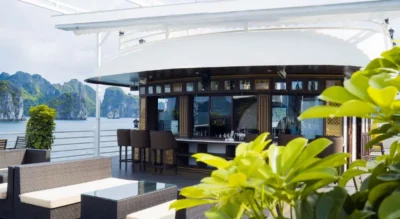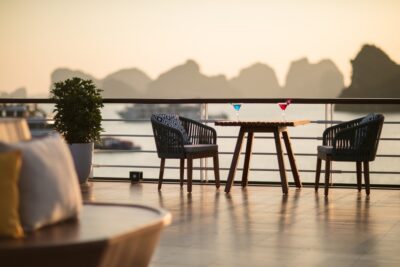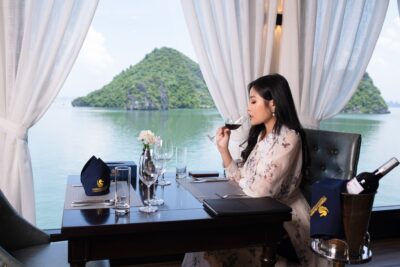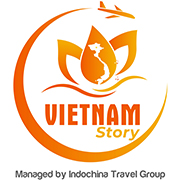Vietnam, a land of vibrant culture, deep history, and breathtaking landscapes for any traveller from India and beyond, is also home to a stunning array of traditional costumes in Vietnam. These garments are far more than just clothing; they are living artifacts, whispering tales of history, ethnic identity, social status, and artistic expression. From the iconic Áo Dài, celebrated for its elegance, to the intricate and colourful attire of the country’s 54 ethnic groups, Vietnamese traditional clothing represents a rich tapestry of heritage, meticulously woven through generations. This article delves into the fascinating world of these costumes, exploring their evolution, variations, cultural significance, and enduring presence in modern Vietnam.

The Enduring Legacy of Traditional Costumes in Vietnam: More Than Just Garments
The significance of traditional costumes in Vietnam extends far beyond their aesthetic appeal. They are deeply intertwined with the nation’s identity, reflecting its diverse history and rich cultural mosaic. Understanding these garments offers a deeper appreciation of Vietnamese heritage.
- A Reflection of Ethnic Diversity: Vietnam’s 54 officially recognized ethnic groups each possess unique traditional clothing styles. These Vietnam costumes showcase a remarkable range of vibrant colors, intricate patterns, diverse materials, and detailed embellishments, serving as powerful visual markers of ethnic identity. This diversity is a testament to the country’s long history of cultural exchange and the resilience of indigenous traditions.
- Evolution Through the Ages: Vietnamese clothing has undergone a continuous evolution, shaped by various historical forces. Indigenous traditions, influences from Chinese dynasties, the impact of French colonialism, and the forces of modernization have all left their mark on the development of Vietnamese dress, including the precursor to the modern Ao Dai, the Áo Ngũ Thân.
- Cultural Significance & Symbolism: Traditional costumes in Vietnam are potent symbols. They represent not only ethnic affiliation but also social status (particularly in the past, where colors like gold signified royalty), marital status, and the specific occasion for which they are worn. Weddings, festivals like Tet (Lunar New Year), religious ceremonies, and even everyday life in some rural communities are all marked by distinctive attire, rich in cultural significance.
- Preservation and Modernization: A Balancing Act: In contemporary Vietnam, there is a conscious effort to both preserve traditional clothing heritage and adapt it to modern life. This involves supporting traditional artisans, promoting cultural awareness through places like the Vietnamese Women’s Museum in Hanoi, and encouraging designers to incorporate traditional elements into contemporary fashion.
READ MORE: A full guide to Vietnamese culture
The Áo Dài: Vietnam’s Elegant National Dress
The Áo Dài, a long, flowing silk tunic worn over wide-legged trousers, is arguably the most recognizable symbol of Vietnamese attire and a key element of traditional costumes in Vietnam. Its elegant silhouette and graceful drape have captivated audiences worldwide, embodying Vietnamese beauty.
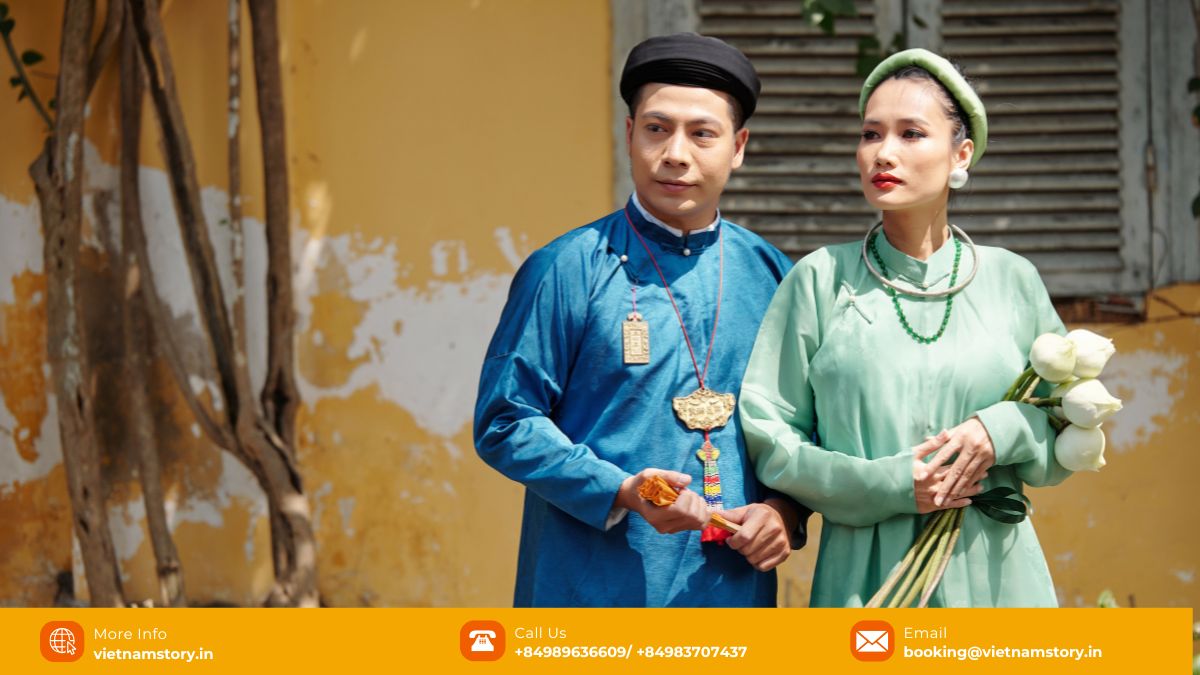
A Journey Through Time: The History of the Áo Dài
The story of the Áo Dài begins long before its modern form. Its roots trace back to 1744 with the Áo Ngũ Thân (five-paneled gown), introduced by Lord Nguyễn Phúc Khoát in the southern territory (Đàng Trong) to distinguish his people. This regal garment, often made of the finest silk with intricate details, laid the foundation. The Áo Dài began to take its modern, more fitted shape in the 1930s, notably redesigned by Vietnamese artist Le Mur Nguyễn Cát Tường. Initially met with hesitation, it gained popularity after Le Mur designed a collection for Queen Nam Phương, wife of Emperor Bảo Đại. Post-1947, following Hồ Chí Minh’s call for more practical attire – a period significantly marked by events like the declaration of independence celebrated on National Day (September 2nd) – the Áo Dài became primarily reserved for professional appearances and special occasions, cementing its status as a cherished national dress of Vietnam.
Structure and Components: The Anatomy of the Áo Dài
- The Tunic: The defining element is the long, flowing tunic, closely fitted to the body with high side slits extending from the waist down. This creates a graceful, flowing silhouette that flatters the wearer’s figure.
- The Trousers: Wide-legged trousers, typically made of silk or a similar flowing fabric, are always worn underneath the tunic. These are usually white or a contrasting color, providing balance and modesty.
- The Accessory (Optional but Iconic): Often paired, especially by women, with the Non La, the traditional Vietnamese conical hat made from palm leaves, adding another layer of cultural identity.
Materials and Craftsmanship: A Canvas of Artistry
Traditionally, silk was the paramount fabric for the Áo Dài, reflecting its status as a garment of elegance. Renowned silk villages like Vạn Phúc near Hanoi continue this tradition. Today, a wider range of materials like satin, brocade, velvet, and chiffon are used, making it more versatile. The artistry shines through embellishments – intricate embroidery, beading, sequins, lace, and hand-painted designs featuring motifs from nature or folklore showcase the handcrafted quality.
Colors and Symbolism: A Language of Hues
The colors of the Áo Dài carry deep meaning, a key aspect of traditional costumes in Vietnam:
- Gold (Vàng): Historically reserved for royalty (kings and queens).
- Red (Đỏ): Worn during Tet for luck and prosperity, also popular for brides and grooms at weddings.
- White (Trắng): Symbolizes purity and innocence, famously worn by female high school students.
- Black (Đen): Primarily worn at funerals.
- Other Colors: Chosen based on personal preference, occasion, or even one’s element (metal, wood, water, fire, earth) determined by birth year.
Variations: Styles for Men, Women, and Modern Times
- Female Áo Dài: The most common form, known for its ankle-length tunic and graceful lines.
- Male Áo Dài: Less common today but worn for special occasions like weddings or Tet. It features a similar tunic (often knee-length or longer), typically made from thicker, more robust fabrics, with a looser cut than the female version.
- Modern Styles: Contemporary designers explore creative variations like boat necks, scoop necks, cropped lengths, shorter sleeves, and knee-length styles practical for motorbikes, showing the adaptability of this Vietnam traditional dress.
When to Wear the Áo Dài: Occasions for Elegance
The Áo Dài graces many significant moments in Vietnamese life:
- Weddings: The quintessential attire for Vietnamese brides and grooms during the traditional ceremony. Guests often wear simpler Ao Dai (avoiding red, the couple’s color).
- Tet (Lunar New Year): Widely worn for visiting family, paying respects at temples, and taking photos.
- Festivals & Formal Events: Appropriate for celebrations, formal gatherings, and important meetings. Many national holidays, such as Reunification Day (April 30th), provide opportunities for Vietnamese people to wear Áo Dài as a display of cultural pride and to commemorate significant historical events.
- Photo Shoots: Popular for capturing memories in beautiful settings, like around Hoan Kiem Lake in Hanoi during autumn.
- School Uniforms: White Ao Dai are worn by female high school students on designated days, an iconic image of Vietnamese youth.
- Respectful Attire: Anyone can wear an Ao Dai as a sign of respect for Vietnamese culture, always ensuring it’s worn over trousers.

Cultural Significance: A Symbol of National Identity
The Áo Dài is more than just a garment; it is a powerful symbol of Vietnamese femininity (though worn by men too), grace, elegance, and national pride. It embodies a blend of tradition and modernity, recognized internationally as an icon of Vietnam.
Beyond the Áo Dài: Exploring Regional & Ethnic Diversity in Vietnamese Attire
While the Áo Dài is the national symbol, the true depth of traditional costumes in Vietnam lies in the incredible diversity of its 54 ethnic groups and distinct regional styles.
Áo Tứ Thân: The Traditional Dress of Northern Vietnam
Predating the modern Áo Dài, the Áo Tứ Thân (four-paneled gown) holds significant historical importance, particularly in the northern regions.

- History: The everyday attire for women in Northern Vietnam for centuries, especially in rural areas.
- Structure: Features a four-paneled outer gown (worn open), an inner bodice (*Yếm* often in contrasting color), a long skirt, and a colorful fabric sash.
- Headwear: Characteristically worn with the *Nón Quai Thao*, a large, flat, round hat.
- Materials: Traditionally silk or cotton, often in earthy tones.
- Significance: Represents Northern Vietnamese tradition, closely linked to Quan Họ folk singing.
Áo Bà Ba: The Everyday Attire of Southern Vietnam
Simple yet elegant, the Áo Bà Ba is the characteristic dress of the Mekong Delta region in Southern Vietnam.
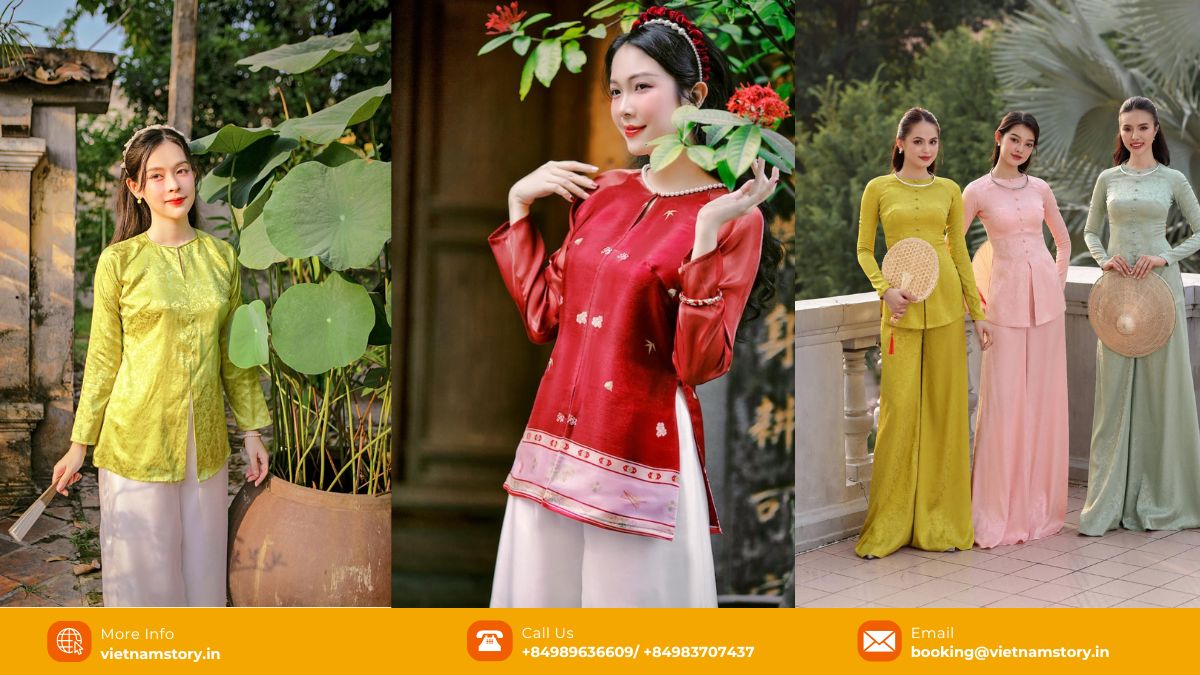
- History: Linked to the practical needs and climate of the Mekong Delta.
- Structure: Consists of a simple, often collarless, button-down shirt (or scoop neck) paired with loose-fitting trousers, usually black or dark.
- Materials: Typically silk or cotton for breathability.
- Significance: Symbolizes the practicality and resilience of rural life in the South.
The Kaleidoscope of Ethnic Minority Costumes in Vietnam
The true visual feast of traditional costumes in Vietnam comes from its diverse ethnic minorities, mainly residing in the northern highlands and central regions. Each group’s attire is a unique language of identity, artistry, and tradition.
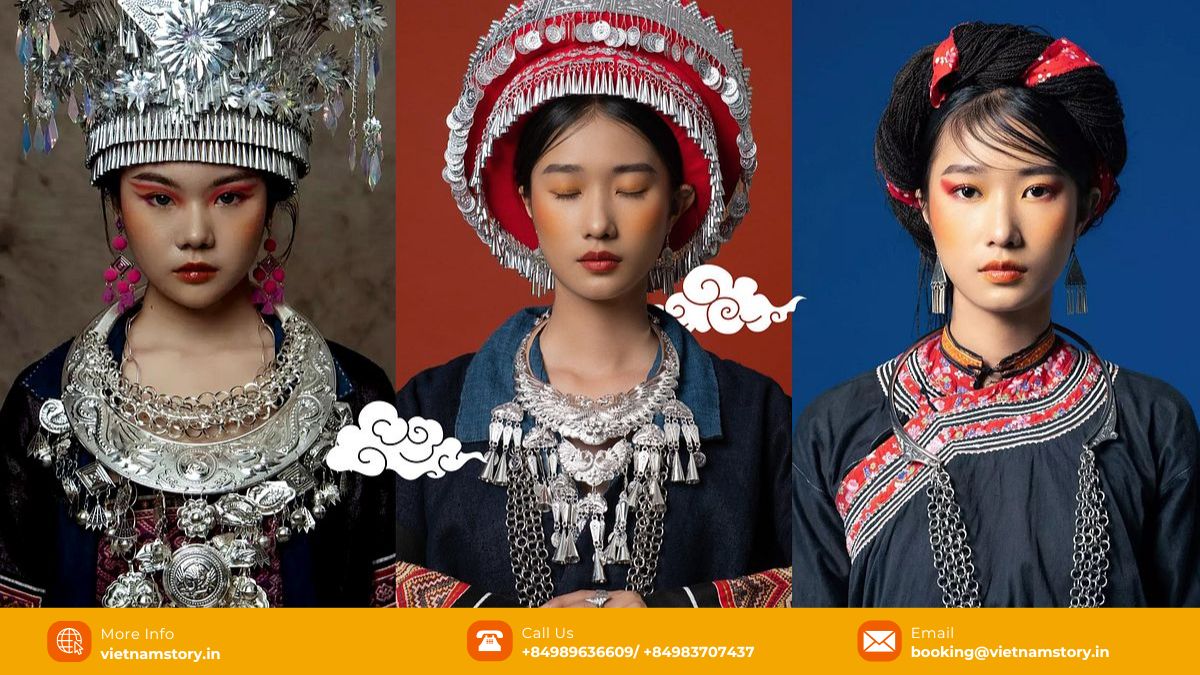
Hmong
Known for their vibrant and intricate textiles, Hmong groups have distinct styles:
- Common Elements: Use of handwoven hemp, intricate embroidery, detailed stitching, and dyeing techniques. Silver jewelry is prominent.
- Flower Hmong: Famous for dazzling colors and complex techniques like reverse applique.
- Black Hmong: Distinguished by their indigo-dyed clothing featuring polished hemp jackets and skirts adorned with beeswax batik patterns.
- White Hmong: Often feature simpler designs with spiral motifs.
Dao (Yao)
Dao groups share linguistic and cultural ties but differ in dress:
- Red Dao: Instantly recognizable by their clothing trimmed with red and white borders, intricately embroidered trousers depicting daily life, and striking headwear often embellished with silver studs, coins, and tassels, including a unique triangular red turban. Bridal headpieces are exceptionally elaborate.
- Dao Chàm (Dao Áo Dài): Named for tunics resembling the Kinh Áo Dài, they wear simpler embroidered headscarves and large, layered silver necklaces.
Tay
As Vietnam’s second-largest ethnic group, their clothing is often more understated:
- Style: Simple black velvet or indigo-dyed jackets paired with pants or skirts. Subtle embroidery may be present.
- Accessories: Women often wear an understated silver hoop necklace and a small black velvet headpiece.
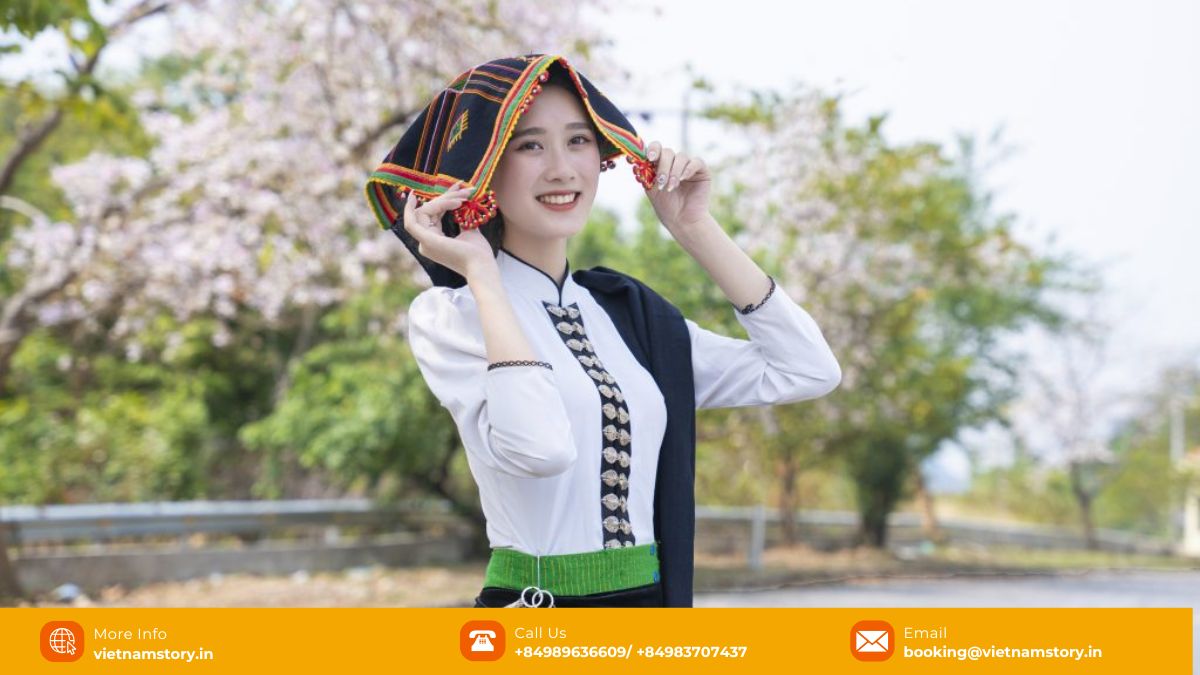
Thai
Thai ethnic groups in Vietnam have elegant attire:
- Women’s Outfit: Consists of a plain but fitted blouse, a long skirt (sinh) often with intricate weaving, and the distinctive Pieu scarf. Belts and silver jewelry complete the look.
- Men’s Outfit: Simpler, often featuring comfortable shirts and trousers or sarongs.
Cham
With historical roots along the central coast and parts of the Mekong Delta, influenced by Indian culture:
- Base Garment: Both men and women traditionally wear a long, one-piece sarong, often made of cotton in white or blue.
- Tops: Women pair the sarong with a long-sleeved pullover blouse; men wear a button-down shirt.
- Features: Headscarves are culturally important for women. Special occasions feature beautifully woven textiles in bold pinks or blues. A key element is the intricately designed waistband.
Khmer
Mainly residing in the Mekong Delta, their clothing reflects their distinct culture:
- Techniques: Known for Tkat and Batik dyeing, creating shiny black silk and cotton.
- Women’s Daily Wear: Often includes colourful collarless shirts and embroidered cloth wrapped into short, bulging pants (a form of sarong or *sampot*).
- Men’s Wear: Features long, embroidered sarongs (*sampot*) often paired with black blouses.
- Festival Attire: More impressive, with brides often in red or lotus pink gowns and grooms in red Hol dresses.
Other Notable Groups (Briefly):
- Ede: Found in the Central Highlands (Dak Lak), women wear striking boatneck shirts and sarong skirts with horizontal stripes; men wear loincloths.
- Muong: Women wear long black dresses with intricately embroidered hems/belts and white/indigo headscarves. Men’s attire is simpler indigo outfits.
- Ha Nhi: Two groups (Den and Hoa) with distinct costumes. Ha Nhi Hoa feature vibrant, layered shirts with colourful embroidery; Ha Nhi Den use simpler black, blue, and white indigo attire.
The Art of Creation: Materials & Techniques in Vietnamese Traditional Dress
The beauty of traditional costumes in Vietnam lies not just in their appearance but also in the materials used and the skillful techniques employed, often passed down through generations.
- Silk (Lụa): The quintessential material for elegance, especially for the Áo Dài. Villages like Vạn Phúc near Hanoi are renowned for high-quality Vietnamese silk.
- Cotton (Vải Bông): A common, breathable material used for everyday wear like the Áo Bà Ba and many ethnic costumes.
- Hemp (Vải Lanh): Crucial for groups like the Hmong, who expertly weave, dye, and embroider this durable fibre. Black Hmong techniques even include polishing hemp for a unique sheen.
- Linen: Another lightweight option used in various traditional garments.
- Brocade (Gấm): Richly patterned fabric, often incorporating silk and metallic threads, used for formal wear and adding luxury.
- Indigo Dye (Nhuộm Chàm): A natural dye creating deep blue/black hues, widely used by ethnic groups in the highlands (e.g., Tay, Hmong, Dao).
- Embroidery (Thêu): A highly developed art form, adding intricate, colourful motifs and personalization to Ao Dai and ethnic attire.
- Batik: The wax-resist dyeing technique famously used by the Black Hmong to create complex patterns on their skirts.
- Weaving (Dệt): Traditional handweaving produces unique textiles specific to different ethnic groups (e.g., Thai, Cham).
- Appliqué: A technique of layering fabric pieces, skillfully used by groups like the Flower Hmong.
Wearing History: Occasions & Cultural Significance of Traditional Costumes
Traditional costumes in Vietnam are donned for more than just daily life; they mark significant cultural moments and express deep-seated identity.
- Identity and Heritage: They are powerful visual markers of ethnic identity and cultural heritage, connecting wearers to ancestors and traditions.
- Social Status: Historically, materials (like gold silk for royalty) and specific designs indicated social rank.
- Weddings: Elaborate costumes are central to Vietnamese weddings for the couple and often guests, signifying the occasion’s importance. The Áo Dài is paramount here.
- Tet (Lunar New Year): As the most important celebration in Vietnamese culture, Vietnam New Year sees widespread wearing of new, often colourful traditional clothes (especially red Áo Dài) for good fortune, family reunions, and temple visits, making it a vivid display of cultural pride.
- Other Festivals: The Mid-Autumn Festival, with its vibrant lanterns and mooncakes, alongside numerous ethnic minority festivals, are also key occasions for showcasing traditional attire, each garment telling a story of local customs and celebrations.
- Religious Ceremonies: Specific garments may be required for rituals, varying by community and belief (e.g., Cham women wearing white for certain masses).
- Performances: Essential for traditional dance, music (like Quan Họ singing associated with Áo Tứ Thân), and theater.
- School Uniforms: The white Áo Dài for female students remains an iconic symbol.
READ MORE: Vietnam’s Festive Calendar
Threads Through Time: Modern Adaptations & Preservation
In contemporary Vietnam, tradition meets modernity as efforts are made to preserve this rich clothing heritage while adapting it for today’s world.
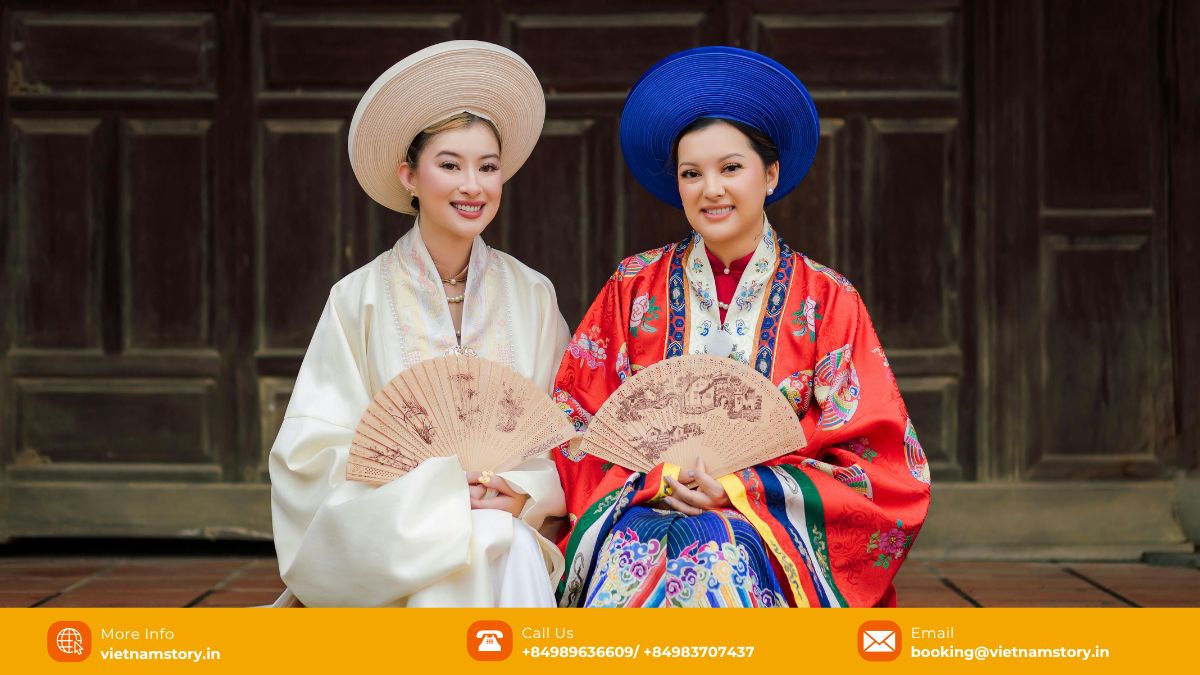
- Contemporary Áo Dài: Designers continually innovate with new fabrics, cuts (shorter lengths, different necklines), and colours while preserving the core elegance, keeping it relevant.
- Fashion Fusion: Elements from traditional ethnic costumes (patterns, techniques) inspire modern Vietnamese fashion designers.
- Cultural Preservation: Museums like the Vietnamese Women’s Museum in Hanoi showcase costume history. Artisan communities receive support to maintain traditional skills like weaving and embroidery.
- Film and Media: Movies like ‘The Tailor’ (Vietnam’s Oscar entry) highlight the place of Áo Dài in fashion history and contemporary life.
- Tourism: Showcasing traditional costumes offers cultural insight for visitors and economic support for artisans. Markets in highland areas and specialized shops offer opportunities to see and purchase items.
- Government Support: Official recognition of cultural heritage helps fund preservation initiatives.
Experiencing Vietnamese Tradition: Tips for Visitors from India
For travellers from India exploring Vietnam, engaging with its traditional costumes can be a rewarding experience. Here are some practical tips:
- Can Tourists Wear Áo Dài? Yes, absolutely! Wearing an Áo Dài is often seen as a sign of respect for Vietnamese culture. Just ensure it’s worn appropriately – always with trousers underneath.
- Color Etiquette at Weddings: If attending a Vietnamese wedding as a guest, it’s thoughtful to avoid wearing red, as this color is typically reserved for the bride and groom.
- Where to See Authentic Costumes:
- Vietnamese Women’s Museum (Hanoi): Offers excellent permanent displays on the history and diversity of Vietnamese attire, including many ethnic costumes and Áo Dài variations.
- Vietnam Museum of Ethnology (Hanoi): Provides deep insights into the cultures and costumes of the 54 ethnic groups.
- Highland Markets: Visiting markets in areas like Sapa, Ha Giang, or Bac Ha offers glimpses of ethnic minorities wearing their traditional dress in daily life.
- Where to Buy or Tailor:
- Ready-to-Wear: Shops in Hanoi’s Old Quarter and the Hội An Ancient Town offer a wide selection of ready-made Áo Dài.
- Tailoring: Hội An is famous for its skilled tailors who can create a custom Áo Dài (or other garments) for you in just a few days. You can choose your own fabric, style, and colors.
- High-Quality Silk: For the best silk, visit Vạn Phúc Silk Village (about 20 minutes from Hanoi). You can buy fabric directly, learn about silk-making, and even get an Áo Dài tailored on-site.
- Appreciating Craftsmanship: Look for hand-embroidered details, handwoven fabrics, and natural dyes when observing or purchasing traditional items – these reflect authentic artistry.
Conclusion
Traditional costumes in Vietnam are a vibrant and enduring testament to the country’s rich history, stunning ethnic diversity, and remarkable artistic traditions. From the globally recognized elegance of the Áo Dài to the intricate, colourful, and deeply symbolic attire of the numerous ethnic minorities, these garments are far more than just clothing. They are living expressions of cultural identity, heritage, and exceptional handcrafted skill. As Vietnam continues to evolve, balancing preservation with modernity ensures that these threads of time – from the shimmer of silk in Hanoi to the earthy hemp of the highlands – will continue to weave a rich and vibrant tapestry for generations to come, offering visitors from India and around the world a unique window into the soul of Vietnam.






